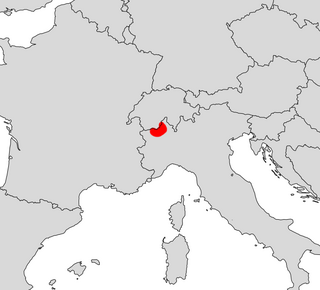
The Catholic Church in Somalia is part of the worldwide Catholic Church, under the spiritual leadership of the Pope in Rome.
Pseudamphidraus is an obsolete spider genus of the jumping spider family, Salticidae. Both described species have only been found in Guyana. The genus was erected by Ludovico di Caporiacco in 1947.
Ludovico is an Italian masculine given name. It is sometimes spelled Lodovico. The feminine equivalent is Ludovica.

The Italian guerrilla war in Ethiopia was a conflict fought from the summer of 1941 to the autumn of 1943 by remnants of Italian troops in Ethiopia and Somalia, in a short-lived attempt to re-establish Italian East Africa. The guerrilla campaign was fought following the Italian defeat in the East African Campaign of World War II, while the war was still raging in Northern Africa and Europe.
Ludovico di Caporiacco was an Italian arachnologist.

Galeodes is a genus of solifuges or sun spiders. The nearly 200 species in this genus are found in northern Africa, southeastern Europe and Asia. Like other solifuges, they are mainly nocturnal and found in arid habitats. They often have long hairy appendages and are not as stout bodied or dark and contrastingly coloured as some other solifuges. Some Galeodes species are able to produce sounds by stridulation. These are usually raspy or hiss-like and may be imitations of the sounds of vipers, to serve a defensive function. As in other solifuges, mating involves the male depositing a spermatogonia that is manipulated into the female genital opening using their chelicera. The male strokes the female using the palps allowing her to be approached. Females will often feed on males before or after mating. The female then deposits the eggs in a burrow in soil and in some species guards them.

The Marquisate or Margraviate of Mantua was a margraviate located in Lombardy, Northern Italy. Placed under the sovereignty of the House of Gonzaga since its erection in 1433, it was further raised to Duchy in 1530.

Galeodidae is a family of solifuges, first described by Carl Jakob Sundevall in 1833.

The Stone Merchant is a 2006 Italian thriller-drama film produced, written and directed by Renzo Martinelli and starring Harvey Keitel. It is based on the novel Ricordati di dimenticarla by Corrado Calabrò.
Ajmonia is a genus of cribellate araneomorph spiders in the family Dictynidae, and was first described by Lodovico di Caporiacco in 1934.
Pararaneus is a genus of orb-weaver spiders first described by Lodovico di Caporiacco in 1940.
Domitius menozzii is an araneomorph spider species of the family Nesticidae. It occurs in Italy, where it can be found in caves. It was described by Ludovico di Caporiacco in 1934.

Aelurillus subaffinis is a species of jumping spider in the genus Aelurillus that lives in East Africa. It was first described in 1947 by Ludovico di Caporiacco based on a specimen that may have come from Tanzania. Only the female has been described. The spider is small. It has a dark brown carapace that is between 3.1 and 3.2 mm long and a yellow abdomen that has a length between 2.75 and 3.8 mm. It has brown chelicerae, a brown-yellow clypeus and yellow legs. The epigyne has a low pocket, distinctive shape and sclerotized flaps. It is similar to the related Aelurillus aeruginosus apart from the copulatory organs.
Innoxius magnus is a harvestman from the genus Innoxius and the family Stygnidae. It was first described by Ludovico di Caporiacco in 1951.

Stenaelurillus albopunctatus is a species of jumping spider in the genus Stenaelurillus that lives in Kenya. It was first described in 1949 by Ludovico di Caporiacco. The spider is medium-sized, with a cephalothorax between 2.24 and 23.55 mm long and abdomen between 2.38 and 3.92 mm long. It has two white stripes on its carapace and white speckles or spots on its abdomen. The female is generally lighter than the male. For example, the female has a brown and yellow carapace, which in the male is brown or black. The female clypeus and legs are yellow, while on the male they are brown. Otherwise, the colouration is similar to many other species in the genus. It is this similarity that led to the species Stenaelurillus guttiger being recognised as a member of the genus. The male has a spatula-like appendage at the front of its yellow pedipalps and a short thick embolus. The female has copulatory openings positioned very closely together and short insemination ducts.
Gluviella is a monotypic genus of daesiid camel spiders, first described by Ludovico di Caporiacco in 1948. Its single species, Gluviellarhodiensis is distributed in Greece (Rhodes).
Rhagodes is a genus of rhagodid camel spiders, first described by Reginald Innes Pocock in 1897.
Rhagodoca is a genus of rhagodid camel spiders, first described by Carl Friedrich Roewer in 1933.

Alpiscorpius beta is a species of scorpion in the family Euscorpiidae. It was described by Ludovico di Caporiacco in 1950.








